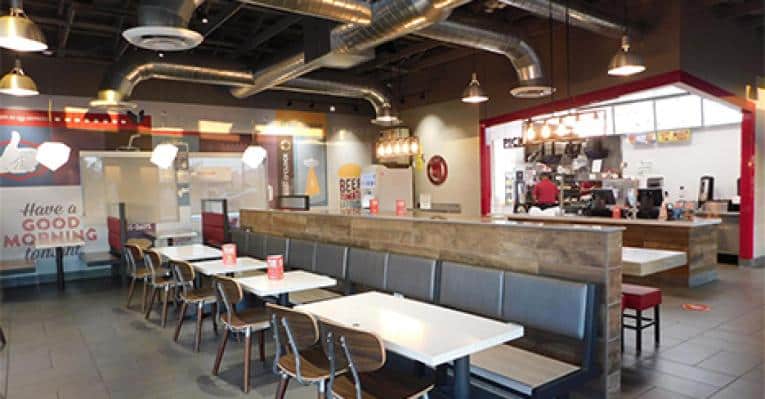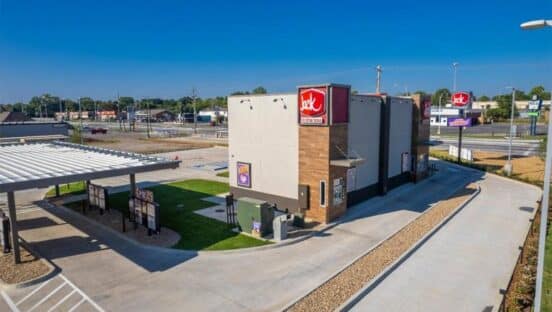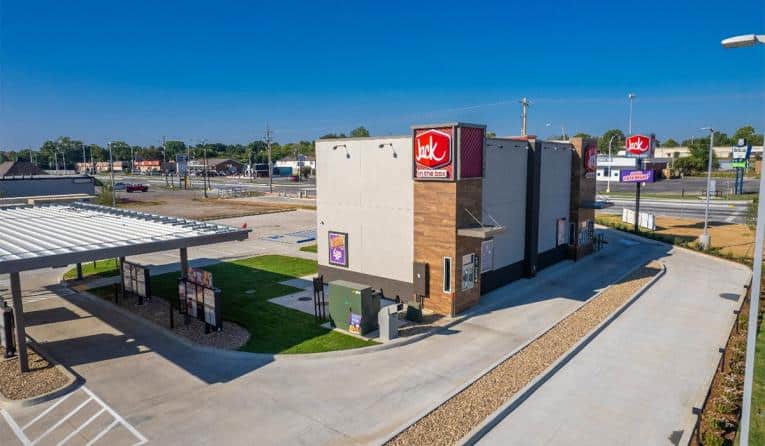Salt Lake City is Jack in the Box’s first new market in over 10 years and marks the first step in an aggressive expansion effort. The 72-year-old legacy chain is making significant progress on its push to reignite franchise growth nationwide.
Jack in the Box unveiled its second drive-thru-only store this week in the Salt Lake City metro area, which comes on the heels of the brand’s first restaurant in the market, which debuted this summer to record-setting results. The chain is racing ahead with plans for two additional units in the market by the end of the year, followed by at least six in 2024—a combination of company-owned and franchised locations.
Over the past two years, the brand has welcomed its first new operators in over a decade and seen the vast majority of its current franchisees sign on to build restaurants in new and existing markets.
That’s a stark contrast to where things stood three years ago, says Van Ingram, vice president of franchise recruitment. Jack in the Box’s footprint had been hovering around 2,200 units for years with limited expansion beyond its home markets out West. The brand had channeled much of its efforts toward refranchising, shifting from an 80 percent company-operated chain to a primarily franchised system. Franchisees simply acquired company-owned stores instead of opening new ones for most of the early 2000s.
Deteriorating relations between operators and the fast-food chain also hindered growth in the years leading up to 2020, when CEO Darin Harris first took charge. The tensions peaked in 2018 when the National Jack in the Box Franchisee Association filed a lawsuit against the franchisor over concerns about marketing funds and remodeling initiatives.
“Franchisees will tell you that before Darin, things had been a little bit contentious,” Ingram says. “One of his key characteristics is his ability to work with the franchise system. When you think about the pandemic, inflation, cost of goods increases, labor increases, and all of the pressures that were put on franchisees, it’s really a testament to his leadership and the team he put into place that so many of them committed to developing new restaurants in such a short period of time.”
In his first few months on the job, Harris settled the lawsuit, reenergized the relationship with franchisees, and laid out the brand’s strategic direction. Operators quickly aligned behind an ambitious agenda to reach 4 percent annual growth by 2025, a presence in 40 states by 2030, and eventually, more than 6,000 restaurants across the country.
Ingram says the first strategy was to reward the loyalty shown by existing franchisees with an incentive for unit development. That included a 0 percent royalty for a specific period of time and a tiered program that reduced royalties for the first six years of operations.
“There’s a lot of money in their pockets by not having to pay a royalty during that time frame,” he says. “That clearly resonated with our franchisee system, and we saw them step up in a big way.”
The incentive rolled out in conjunction with a strategic market plan that utilized mapping and data analytics, plus demographic and psychographic profiles, to prioritize growth decisions based on expansion potential.
“We did a profile of our most successful locations across the country,” Ingram says. “We looked at the tie-ins, like big box retail, other quick-service restaurants, schools, and all of the different things that you want to be near when you’re developing a restaurant. We loaded all of that into a computer program. It kicked out our strategic market plan that designates the trade area market points that make the most sense for a new location.”

Jack in the Box identified over 1,500 opportunities for potential stores in its existing 21 states and more than 2,250 opportunities for potential stores in the 29 states where it didn’t have a presence. From there, it began working hand-in-hand with franchisees to leverage that market plan to drive sites into the pipeline. It adopted a three-pronged strategy centered around bolstering its presence in established markets, entering adjacent markets through a “wagon wheel” approach, and pinpointing strategic regional hubs to serve as foundations for expansion in untapped regions.
“It was a great way to show our franchisees where we felt we needed to add locations, and it gave them a chance to lock up the available opportunities in their current geography,” Ingram says.
With more than two-thirds of the current system approved to expand, Jack in the Box last summer launched an incentive for new franchisees. Operators that agreed to build at least three locations received a discounted royalty structure that starts at 1 percent in the first year and reaches 4 percent in the fourth year, with a consistent rate of 5 percent for the remainder of the agreement. Franchisees who signed on by March of this year stood to save up to $180,000 in payments during the initial few years of operations.
The company has been building on the momentum sparked by those incentives and the strategic market plan with a host of initiatives, all geared toward making the franchise opportunity more appealing to operators. It shuttered underperforming locations and bought out struggling markets to optimize them for fresh development. It also identified 200 basis points of restaurant-level margin improvement.
“Whether it is with new technology, equipment, processes, or supply chain synergies, we identified initiatives that could result in potential annualized savings of $55,000 per restaurant,” Harris said during the company’s Q3 earnings call last month. “We’ve rolled out 50 percent of these programs and are beginning to see them take hold.”
A major step in Jack in the Box’s evolution came last fall when the brand debuted its CRAVED image for future stores. The acronym stands for “Cultural, Relevant, Authentic, Visible, Easy, and Distinctive.”
Multiple store models are available under the CRAVED image, including the drive-thru-only prototype that debuted in Tulsa, Oklahoma, late last year. It features a double drive-thru, a walk-up window for ordering, dual assembly kitchens, and a dedicated pickup window for mobile and third-party delivery orders. The goal was to reduce build-out costs by 20 percent while also increasing real estate flexibility. The prototype was designed for free-standing locations but can be adapted to fit in a variety of spaces, including c-stores, travel plazas, and end-cap locations.
“Reducing the square footage of the building and making it a little bit smaller allows us to get some labor efficiencies, and it certainly allows us to get some construction efficiencies, as well,” Ingram says. “With the drive-thru-only building, you can go into dense metropolitan areas where land is limited and where you have less opportunities to pick up the traditional freestanding quick-service restaurant property.”
Jack in the Box also offers two larger-format CRAVED prototypes that feature different seating options. Like the off-premises prototype, they come with eye-catching exterior elements, including a “big red box” on the facade that pays homage to the brand’s namesake and lighting that switches to its signature purple color to signify late-night menu hours.


“A lot of the other nationally known brands either have territory commitments in place, or they’re sold out from a development perspective. It’s pretty compelling to see an iconic brand with a 70-plus-year legacy that still has so much territory available,” say Van Ingram, Jack in the Box’s vice president of franchise recruitment.
“When you look at these buildings, the real concentration is improving drive-thru efficiency, but we also have a building with a modest seating capacity and a building with a more robust seating complement under the CRAVED image,” Ingram says. “Most of our franchisees are still going to want to have in-store seating, even if it’s a smaller portion of our business today than it was in the past. There’s just a lot of benefits of having these new prototype buildings with a flexible layout to take advantage of all the site opportunities that are out there.”
Jack in the Box also is helping operators update existing restaurants with the CRAVED image and design elements. It has a tiered remodeling initiative, with some stores receiving a low-cost exterior refresh and others receiving more extensive upgrades.
“We have a goal of remodeling all of our stores within the next five to seven years, and to support franchisees with this, we’ve shown our commitment by contributing funds for remodels that meet certain criteria,” Ingram says. “That’s key for anyone that’s looking at our brand. They want to see that we’re committed to updating our locations, so they know that when they join, they’re going to be surrounded by other nice looking, new, modern facilities.”
The initial store in Salt Lake City was the first to feature the CRAVED image with dine-in seating. It launched in June with strong results. Full-first-month sales outperformed the previous record-setting new market opening by 66 percent, and sales have continued to grow week-over-week since then.
Harris credits those results to a new market opening playbook created by the brand’s marketing and operations teams. It focuses on recruitment and training “to make sure operations are executing at the highest level” along with social and digital channels for early market entry announcements.
“It was not only our inaugural restaurant in this market, it was also our first restaurant to execute against this playbook,” Harris said during last month’s earnings call. “It’s working even better than we anticipated.”
Salt Lake City is an example of a “wagon wheel” market with strong familiarity and built-in demand. The company also is gearing up to open two corporate stores under the new CRAVED image in Louisville in Q4. That represents a new market with less proximity to core territories. It could serve as a strategic hub for the brand as it charts further expansion throughout the Midwest and Southeast.
“We’d like to see people developing in Lexington, Cincinnati, Indianapolis—kind of the bleedout markets from Louisville on the same interstate system,” Ingram says.
Since mid-2021, Jack in the Box has signed a total of 77 new agreements for 340 restaurants. It has backfilled current operations in a growing number of markets, including Houston, Phoenix, San Francisco, Los Angeles, Baton Rouge, Dallas, St. Louis, and Charlotte, to name a few. It also has inked deals to enter Arkansas, Wyoming, and Montana, where it’s never been before, and Florida, where it hasn’t had a presence in over three decades.
While there’s ample opportunity to build new restaurants across much of the country, the brand is focused mainly on entering new markets east of the Mississippi River, and throughout the Southeast and Mid-Atlantic regions in particular. Ingram says his team shows prospective new franchisees the strategic market plan and allows them to select the individual trade area market points that they want to develop.
“We’ve done the homework on the front end, so by the time we get ready to assign someone to a new development agreement, we have a really good understanding of where we’d like to go,” he says. “A lot of the other nationally known brands either have territory commitments in place, or they’re sold out from a development perspective. It’s pretty compelling to see an iconic brand with a 70-plus-year legacy that still has so much territory available for somebody that wants to come in and develop multiple locations. The sales proposition that we talk about the most with prospective franchisees is the ability to take this into a new market.”






